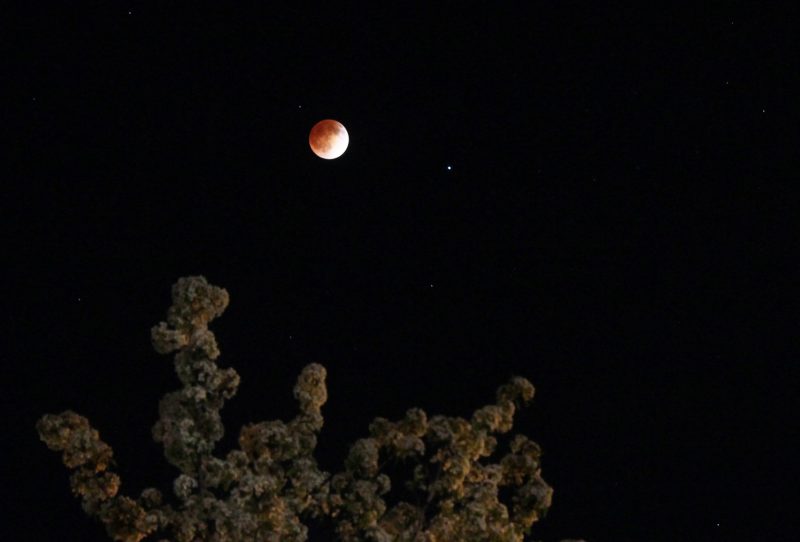-
Skywatchers in most of Africa, Europe, Asia and Australia may also see a lunar eclipse, or Blood Moon.
South African sky-gazers are in for a treat as a rare total lunar eclipse, commonly known as a “Blood Moon,” paints the night sky with hues of fiery red.
According to the National Research Foundation, the event promises to be the longest total lunar eclipse in recent times, making it an unmissable opportunity for sky enthusiasts.
The eclipse will be visible from various locations across South Africa, and other parts of the world, tonight.
The entire event will last for a few hours, with the moon taking on a deep reddish colour as it passes through the Earth’s inner shadow.
It is expected to take place from 7.30PM local time in South Africa.
WATCH | South African sky-gazers are in for a treat as a rare total lunar eclipse, commonly called a Blood Moon, is expected to paint the night sky with fiery red hues tonight. pic.twitter.com/MdTg1Eck2G
— SABC News (@SABCNews) September 7, 2025
A lunar eclipse happens when the Earth positions itself precisely between the moon and the sun, casting its shadow on the moon’s surface.
This occurs during a full moon, when the Earth, Moon, and Sun are aligned in a straight line, a phenomenon known as syzygy.
As the Earth blocks direct sunlight from reaching the moon, its shadow falls on the lunar surface, causing the eclipse, also known as a ‘Blood Moon’.
At Dithothwaneng Senior Secondary School in Mphanama outside Jane Furse, in Limpopo, a teacher has prepared a lesson for his Grade 12 learners about this rare occurrence.
He says the eclipse will be visible from various locations across the country, where the maximum view will occur at 20h00.
“A lunar eclipse is a celestial event where in the celestial bodies, which is the earth, the sun, and the moon will be aligned in what astronomical mechanics refers to its syzygy, where in the moon the sun and the earth will be in a straight line. Therefore, the moon will be behind the shadows of the earth and this celestial experience is going to make learners, teachers ,scholars academics and astronomers to be engaged all together at the same time because it is an experience to be experienced by everyone at the same time,” says teacher, Eric Masweneng.
It’s a full moon today! 🌕
Skywatchers in most of Africa, Europe, Asia and Australia may also see a lunar eclipse, or Blood Moon. Totality will begin around 1730 UTC and last for about 82 minutes.
No matter where you are, you can learn how eclipses work: pic.twitter.com/pxXFRnSjUE
— NASA (@NASA) September 7, 2025
A lunar eclipse also holds cultural significance in African culture and is described differently.
A traditional leader and healer says this phenomenon usually occurs in September, which signifies the beginning of the year, according to the African calendar.
“In African culture, lunar eclipses hold significant meaning. Typically occurring in September, which marks the beginning of the year, these events are believed to signal various changes. When the moon turns red, it is thought to foretell strong winds and potential sicknesses brought on by these sudden strong rush of wind. Conversely, a red moon can also be an indication of an abundant harvest, bringing prosperity to agricultural communities,” says Traditional healer and leader, Mpatametse Mokgoadi.
He says that stars and galaxies are also interpreted and hold significant meanings in African culture.
Mokgoadi says the moon and stars hold various meanings in our culture. Often, a lunar or solar eclipse signifies the passing of a king.
“Additionally, when we observe a star moving rapidly with a long tail, it is believed to indicate that a king has died in that specific direction. Each star has its own significance, with some signalling impending rain and others indicating a period of drought,” adds Mokgoadi.
Sky enthusiasts across South Africa are eagerly anticipating this rare event, and with clear skies predicted, conditions are expected to be ideal for viewing.
The National Research Foundation says South Africans can expect the reddish colour to be most striking between 19:30 and 20:52 SAST, fading as the eclipse exits.
The partial phase will end around 21:56, with penumbral shading lingering until 23h55, in Cape Town.











